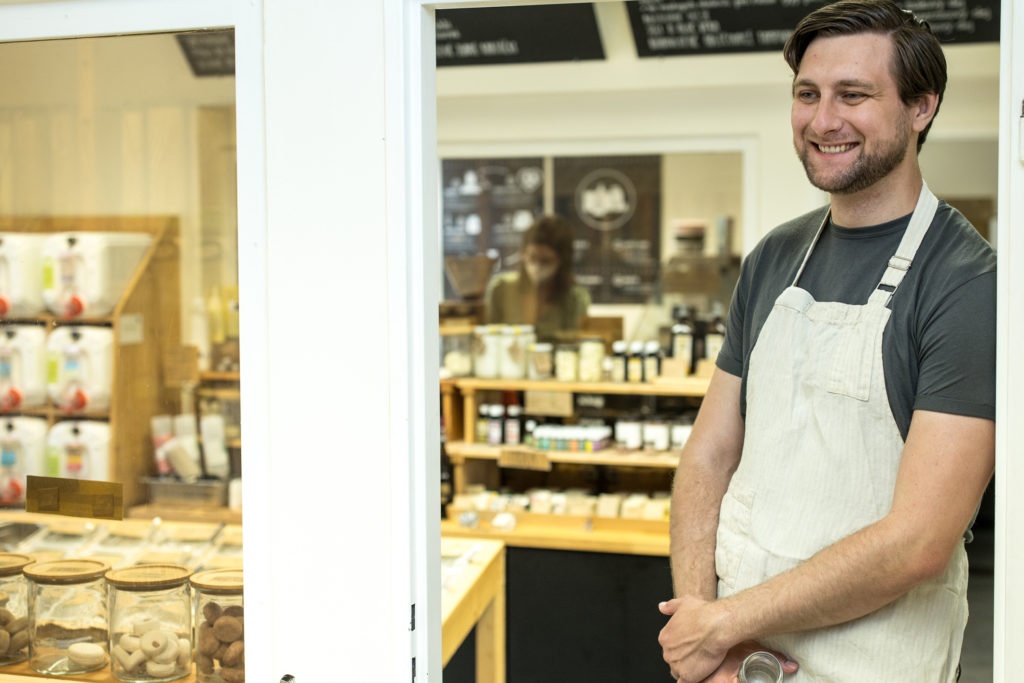With a lot of Australians still on holiday and many businesses taking a break, your digital marketing is probably the last thing on your mind. Now, however, is a perfect chance to get organised with your marketing plans for the year ahead and factor in any lessons you’ve learnt from 2023.
From the rise of AI to Google’s Helpful Content update, to new social media features, such as Instagram Threads and YouTube shorts, digital marketing is always changing — and it’s important to keep up with recent trends in marketing if you want to stand out and get more customers.
Here are seven digital marketing trends to incorporate into your business strategy in 2024.

1. The AI revolution marches on.
In 2024, AI will continue to become even more prevalent across the marketing industry.
Many businesses are already utilising one AI marketing tool – chatbots. When a customer messages a brand via social media or on their webpage, automated chatbots are an excellent tool for answering reasonably straight-forward questions and passing the customer onto a human should the bot not be able to help.
Chatbots are becoming so popular that Stella Connect’s Customer Service Trends report predicted that by the end of 2025, 95% of customer interactions with brands will be via artificial intelligence (AI), such as chatbots. With natural language processing (NLP) and machine learning consistently improving, chatbots have the ability to be conversational and assist customer queries with real-time answers.
But chatbots aren’t the only trend in AI marketing. Businesses are turning to AI for everything from copy-writing, to personalised recommendations, email marketing, data analysis and much more, saving time and money in the process. In fact, a recent McKinsey report estimates that AI could contribute up to $4.4 trillion in global productivity per year.
In 2024, businesses should also look into how AI can help them target ads to the right customers, personalise offers, segment audiences and even create the perfect social media post.

2. Social shopping will continue to thrive.
The transformation of social media platforms into consumer hubs has proceeded apace over 2023, with the trend expected to continue into 2024 and beyond.
Facebook, Instagram, Snapchat and TikTok now offer ways to sell your products, and so it’s no surprise that 71% of Gen Z-ers and 52% Millennials prefer to discover new products on social media.
Additionally, users are increasingly using social media platforms as search engines, actively seeking out products, services and content via hashtags or the search function within each platform. A recent survey of Gen Z women found that 51% preferred TikTok to Google as a search engine due to the video format of the search results and the more relatable and personalised answers they received.
This merging of social media with eCommerce offers businesses an economical opportunity to foster a more personalised relationship with your audience and potential customers that can be the key to differentiating your brand from your competitors.
RELATED: eBook: Social media advertising for small businesses

3. Short-form video leads the way.
Since the explosion of short-form video, Instagram Reels, YouTube Shorts and TikTok have been a strategy in every content marketer’s playbook.
And just like 2023, the growth rate for short-form video continues to accelerate as we move into the year ahead.
One-third of marketers already utilise short-form video, however it was predicted that 90% would increase or maintain their investment in 2023 and 21% would leverage this content-type for the first time last year.
This prediction seems to have been borne out according to the following statistics from Yaguara:
- 73% of consumers prefer short-form videos to search for products or services
- 57% of Gen Z prefer short videos to learn about products and services
- 85% of marketers believe short-form videos are the most effective format for video content
- Short-form videos receive 2.5 times more engagement than long-form videos.
Set yourself a goal to play around with videos and live streaming as part of your social media marketing in 2024, whether for social media content or for advertising.
Not sure where to start? Our article, 5 simple tips for creating short-form video content, has everything you need to know to jump on board with this exponentially growing trend.

4. Hyper-personalisation is key.
The ability to segment your audience – on social media, in eDMs and via CRM systems such as Thryv – has enabled a never seen before level of personalisation in your marketing and customer relations. And, as this trend grows, more and more consumers have come to expect a highly tailored experience when interacting with businesses online. In fact, Deloitte reports that 90% of customers find personalised marketing appealing.
In this changed marketplace, knowing how to connect with your audience and foster those relationships can result in more conversions and greater brand loyalty and advocacy. This could mean personalised emails based on prior purchases, targeted social media ads that provide useful content to your followers, or requests for reviews following a successful transaction.
Whatever form your marketing personalisation takes, in the end it’s all based on using your customer data wisely and leveraging AI to save you time and money in the long run.

5. Privacy and first-party data takes precedence.
With Google Chrome set to terminate third-party cookie support by the end of 2024, we are well on track to our cookieless future. Now more than ever it is critical that businesses shift focus to first-party data (1PD) and develop new marketing strategies to carry out future-proof campaigns.
Third-party cookies have been a boon for marketers, as they collect data from users as they move about the internet, making it easier for marketers to target specific groups and enjoy the increased engagement and sales that comes from superior user information.
But third-party cookies are soon to be no more as Google aims to tighten up its privacy settings for users. This means marketers are having to change tack to find new ways to collect and use customer data.
As noted in the Deloitte 2022 Global Marketing Trends Report, 61% of high-growth brands are already shifting to a first-party cookies strategy in the wake of the move, which is expected to increase over the next few years. While 1PD can present more challenges than third-party cookies, it can provide a qualitative understanding of customer needs and preferences. Marketers will also own the data, which can help protect you against privacy risks.
First-party cookies are when a website collects data from a user as the user moves around their own website. It is more limited, but also more acceptable in terms of privacy, and users can even switch first-party cookies off if they prefer.
There’s a couple of strategies that businesses can look to incorporate moving ahead of the update. Investing more into upscaling consumer data platforms, putting first-party cookie data to better use with things like email optimisation, and experimenting with new ways of collecting data, such as loyalty programs.
And the good news is that Google hasn’t completely abandoned marketers when it comes to data possibilities. They have announced the introduction of Federated Learning of Cohorts (FLoC) marketing, which offers a compromise between privacy and useful data by collecting information in ‘cohorts’ that marketers can effectively use to target certain groups of customers.
RELATED: No more third-party cookies: What this means for your online marketing.
6. Optimising for voice search is essential.
Connected to the rise of AI and virtual assistants, such as Siri and Alexis, voice search is now one of the most used methods for finding things online. In fact, in 2023, 57% of Australians used voice search and, according to global statistics, 55% of these searches are for local businesses.
To tap into this growing trend, you need to ensure your online presence is optimised for voice search. This not only entails optimising your website for key search terms and phrases, it also applies to your Google Business Profile and online directory listings. Keeping these up to date and accurate, with relevant location-based information, is key to your business appearing in voice search results.
RELATED: 6 critical SEO trends to embrace in 2024.

7. Sustainability takes centre stage.
Australians and people around the world are increasingly concerned about the environment and are interested in supporting brands who share those concerns and offer sustainable products and services.
In Google’s own research, they found that 82% of people say that sustainability is more top of mind now than it was before the pandemic and, as a result, they are looking for simple, everyday ways they can live more sustainably.
Google suggests that businesses get behind this movement by ‘weaving sustainability into the existing value proposition, rather than positioning it as a bonus feature’.
Google is even taking a swig of its own medicine by introducing an ‘eco-friendly’ option to its maps. Users can now take the sustainable route from point A to point B, instead of simply the fastest. Google is adding this feature as a default, but offering users the option if a less-sustainable route is significantly faster, and adding carbon-footprint information to its results.
And Google is certainly not the only brand switching to more sustainable practices. Fashion brand H&M has switched to sustainable packaging, citing the increase in online shopping as a big driver behind the need to make the change.
National Australia Bank is promoting its sustainable practices, from reducing paper waste by 67% in 2022 to sourcing almost three quarters (72%) of their energy from renewable sources.
At Thryv, Yellow Pages and White Pages have both been declared as carbon neutral by the Australian Government. We have Forest Stewardship Council Certification and we’re very careful about distributing physical books, ensuring they only go to people who are likely to use them and get value from them.
Of course, moving to more sustainable practices should be front of mind for any Australian business for the sake of the environment. But marketing managers should also share those practices as part of their marketing strategies to connect with environmentally-minded consumers as well.
So in 2024, the move to highlighting a brand’s sustainability is sure to grow.
Need help getting your marketing off to a good start in 2024?
By keeping your eye on these top 2024 digital marketing trends, you’ll set your business up for success in the coming year and beyond.
And, if you’d like a hand setting up your marketing, creating strategies, ranking well on Google, building your social media presence, or anything in between, the experts at Yellow Pages are just a message away.
Let us know how we can help you get your 2024 marketing off to a flying start. Get in touch today.
